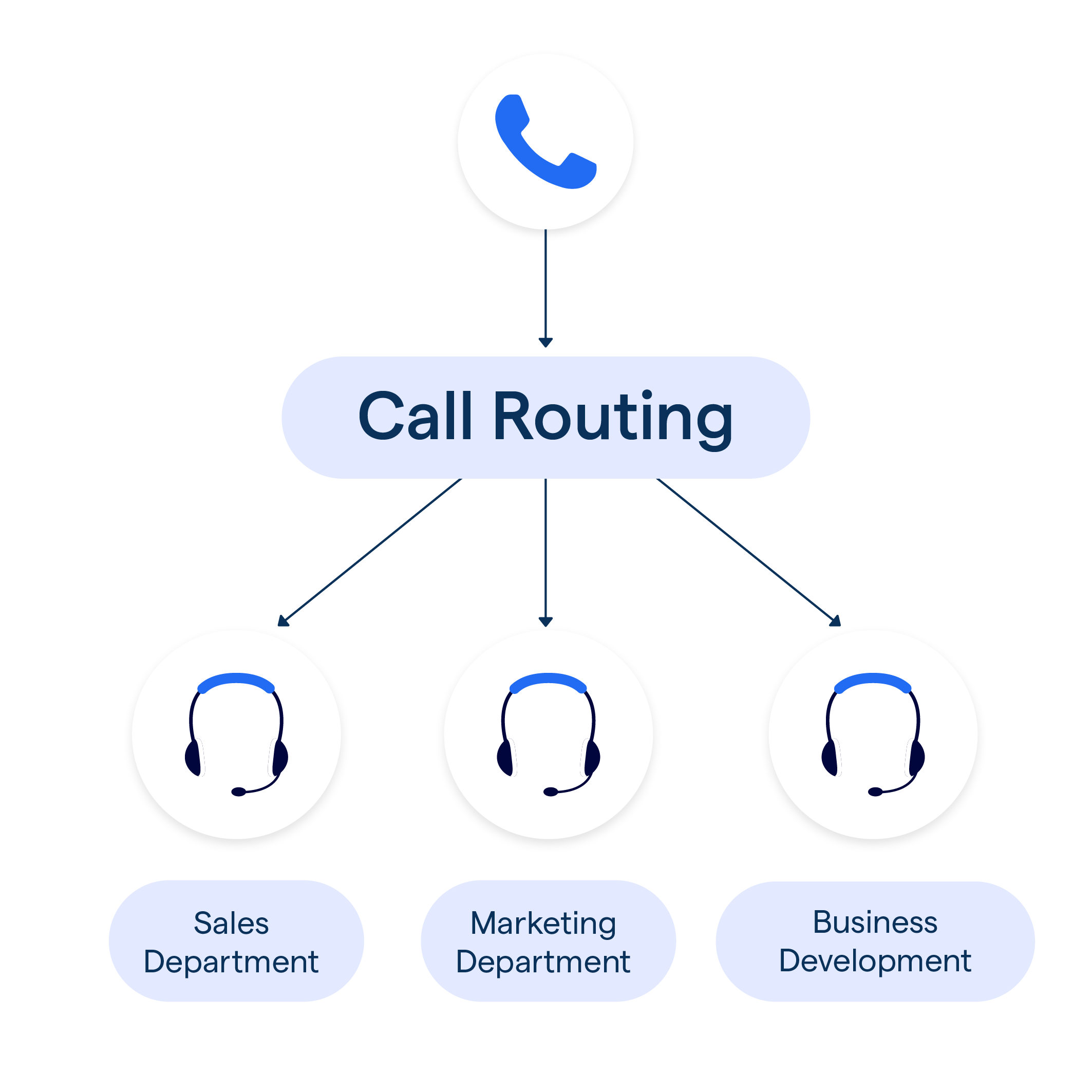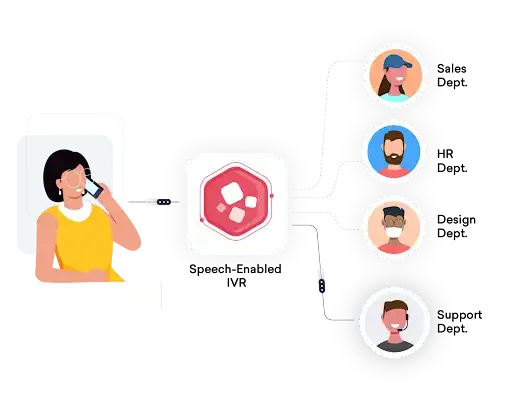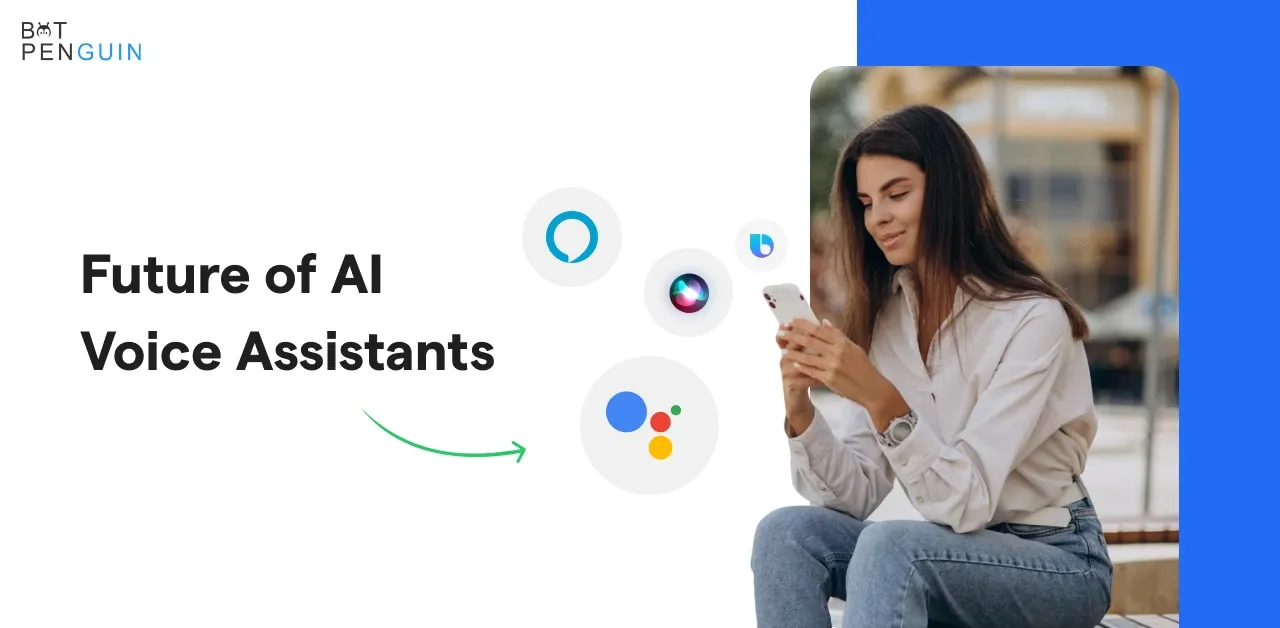Introduction
As businesses of all sizes rely heavily on phone systems for their communication needs, optimizing this aspect becomes imperative.
And what’s the best solution? Answer is just two words: call routing.
Call routing is a powerful tool that can help businesses to streamline their phone systems and improve customer service. By directing incoming calls to the appropriate person or department, businesses can reduce wait times, increase efficiency, and provide a better overall experience for their customers.
Call routing offers flexibility and customization. Thus allowing businesses to tailor call routing options based on their unique needs and preferences.
For businesses looking to streamline operations and enhance their phone system efficiency, call routing is the answer. So continue reading to know more about the power of call routing.
What is Call Routing?

Call routing allows businesses to direct incoming calls to the appropriate person or department. It can be set up to route calls based on various criteria such as the time of day, the caller's location, or the purpose of the call.
For example, a customer calling a bank might be routed to the loan department if they are calling about a loan, or to the customer service department if they have a general inquiry.
The Importance of an Efficient Phone System
An efficient phone system is essential for businesses to provide excellent customer service. Customers expect to be able to reach the right person quickly and easily.
If they are directed to the wrong department or have to wait on hold for too long, they may become frustrated and take their business elsewhere. An efficient phone system can help to prevent this by ensuring that calls are routed to the appropriate person or department as quickly as possible.
Why you need Call Routing
Call routing is an effective tool that can help businesses to streamline their phone systems and improve customer service. In this section, we will explore call routing benefits and how they can improve customer experience and increase productivity.
Benefits of Call Routing

Call routing for business offers several benefits, including:
Improved Customer Experience
One of the most significant benefits of call routing for business is improved customer experience. By directing incoming calls to the appropriate person or department, businesses can reduce wait times and provide a better overall experience for their customers. This can help to increase customer satisfaction and loyalty.
Increased Productivity
Call routing options can help to increase productivity by ensuring that calls are directed to the appropriate person or department. This can help to reduce the amount of time spent transferring calls or dealing with inquiries that are outside of a particular department's scope.
As a result, businesses can handle more calls and inquiries in less time, increasing productivity and efficiency.
Cost Savings
Call routing can help to reduce costs by ensuring that calls are directed to the appropriate person or department. This can help to reduce the number of staff required to answer calls, as well as reduce the amount of time spent on each call. As a result, businesses can save money on staffing costs and increase profitability.
How Call Routing Can Improve Customer Experience
Call routing can significantly improve customer experience by ensuring that calls are directed to the appropriate person or department. This can help to reduce wait times and provide a better overall experience for customers.
Additionally, it can help to ensure that customers are connected with the right person who can help them with their inquiries, reducing frustration and increasing satisfaction.
How Call Routing Can Increase Productivity
Call routing can help to increase productivity by ensuring that calls are directed to the appropriate person or department. This can help to reduce the amount of time spent transferring calls or dealing with inquiries that are outside of a particular department's scope.
As a result, businesses can handle more calls and inquiries in less time, increasing productivity and efficiency.
Suggested Reading:
5 Key Considerations When Choosing a Call Routing System
Who can benefit from Call Routing?
In this section, we will explore who can benefit from automatic call routing and provide specific examples of businesses that have successfully implemented it.
Businesses of All Sizes
Call routing benefits businesses of all sizes, from small startups to large corporations.
Small businesses can use it to ensure that calls are directed to the appropriate person or department, even if they have a small team.
Large corporations can use automatic call routing options to handle high call volumes and ensure that calls are directed to the appropriate call center or department.
Industries that can benefit from Call Routing
Call routing benefits a wide range of industries, including:
Healthcare

Healthcare providers can use call routing software to direct calls to the appropriate department or specialist, reducing wait times and improving patient care.
Financial Services
Financial services companies can use call routing to direct calls to the appropriate department, such as loans or credit cards, improving customer service and increasing efficiency.
Retail
Retail businesses can use it to direct calls to the appropriate store location or department, improving customer service and reducing wait times.
Specific Examples of Businesses that have Successfully Implemented Automatic Call Routing
Several businesses have successfully implemented Call routing to improve their phone systems and customer service. For example:
Zappos

Zappos, an online shoe and clothing retailer, uses automatic call routing software to direct calls to the appropriate department, such as customer service or returns. This has helped to reduce wait times and improve customer satisfaction.
Mayo Clinic
Mayo Clinic, a healthcare provider, uses call routing to direct calls to the appropriate department or specialist, reducing wait times and improving patient care.
Bank of America
Bank of America uses call routing to direct calls to the appropriate department, such as loans or credit cards, improving customer service and increasing efficiency.
How to Set Up Automatic Call Routing
Setting call routing up can seem daunting, but it doesn't have to be. In this section, we will explore the steps to setting up the software, important factors to consider, and best practices for call routing setup.
Steps to Setting Up Automatic Call Routing
The steps to set up automatic call routing are the following:
Step 1
Determine your needs
Decide what types of calls you want to route and to which departments or individuals.
Step 2
Choose a system
Choose a system that meets your needs and budget.
Step 3
Set up your call routing system
Follow the instructions provided by your system to set up your call routing rules and preferences.
Step 4
Test your system
Test your system to ensure that calls are being directed to the appropriate department or individual.
Step 5
Monitor and adjust your call routing system
Monitor your system regularly and make adjustments as needed to ensure that it is meeting your needs.
Important Factors to Consider When Setting Up Automatic Call Routing
When setting up, it's important to consider the following factors:
Call Volume
Consider the volume of calls your business receives and ensure that your call routing software can handle the volume.
Call Types
Consider the types of calls your business receives and ensure that your system can route calls to the appropriate department or individual.
Business Hours
Consider your business hours and ensure that your system is set up to handle calls outside of business hours.
Taking your first step toward chatbot integration isn't that tough. Meet BotPenguin- the home of chatbot solutions. With all the heavy work of chatbot development already done for you, move forward to setting up a top-notch chatbot for your business with features like:
- Marketing Automation
- WhatsApp Automation
- Customer Support
- Lead Generation
- Facebook Automation
- Appointment Booking
Best Practices for Call Routing Setup
To ensure that call routing is set up for success, consider the following best practices:
Keep it simple
Keep it simple and easy to understand for both workers and clients.
Be transparent
Be transparent with clients about how the system works and what they can expect when they call.
Monitor and adjust
Monitor it regularly and make adjustments as needed to ensure that it is meeting your needs.
Call Routing Best Practices
To get the most out of call routing, it's important to follow best practices. In this section, we will explore tips for optimizing call-routing software and common mistakes to avoid when implementing automatic call-routing options.
Tips for Optimizing Call Routing
To optimize your system, consider the following tips:
Personalize the experience
Personalize the experience by using customer data to route calls to the appropriate department or individual.
Use interactive voice response (IVR)

Use interactive voice response (IVR) to provide customers with options for routing their calls, such as selecting a department or entering an account number.
Route calls based on agent skills
Route calls to agents based on their skills and expertise to ensure that customers are getting the best possible service.
Monitor call routing performance
Monitor performance regularly to identify areas for improvement and make adjustments as needed.
Common Mistakes to Avoid When Implementing Call Routing
To avoid common mistakes when implementing automatic call routing, consider the following:
Overcomplicating the system
Avoid overcomplicating the call routing software by keeping it simple and easy to understand for both employees and clients.
Not testing the system
Test the system thoroughly before implementing call routing to ensure that it is working properly and directing calls to the appropriate department or individual.
Ignoring customer feedback
Pay attention to customer feedback and make adjustments to the system as needed to improve the customer experience.
Conclusion
In conclusion, the power of call routing cannot be overstated in streamlining your phone system and optimizing communication processes within businesses.
By leveraging call routing software and embracing automatic call routing options, organizations of all sizes and across diverse industries can unlock a multitude of benefits. From improved call management to enhanced customer service delivery, the advantages are significant.
Implementing call routing empowers businesses to efficiently handle incoming calls, directing them to the most appropriate departments or individuals based on predefined criteria. This not only reduces call waiting times but also ensures that customer inquiries are addressed promptly and effectively.
Moreover, call routing allows for flexibility and scalability. It enables businesses to adapt to fluctuating call volumes and evolving customer needs seamlessly.
For businesses seeking to enhance their phone system efficiency and elevate customer service standards, embracing call routing is imperative. It offers a strategic solution to streamline operations, optimize resource allocation, and ultimately drive business growth.
These days, customer experience is paramount. So, integrating call routing into your communication infrastructure is not just an option but a necessity.
Frequently Asked Questions (FAQs)
What is call routing and how does it work?
Call routing is a system that directs incoming calls to specific destinations within an organization. It operates based on predefined rules such as time of day, caller's location, or purpose of the call. When a call comes in, the system analyzes these parameters and routes the call accordingly. Thus ensuring it reaches the most appropriate person or department.
What are the benefits of implementing call routing?
Implementing call routing streamlines phone system operations by efficiently distributing incoming calls. This enhances customer satisfaction by reducing wait times and ensuring calls are directed to the right personnel promptly. Additionally, it optimizes resource allocation within the organization, leading to increased productivity and cost savings.
How customizable is call routing for different business needs?
Call routing systems are highly customizable, allowing businesses to tailor routing rules to suit their specific requirements. Whether it's prioritizing certain callers, routing calls based on language preferences, or directing calls to different locations, the flexibility of call routing ensures adaptability to diverse business needs.
What are some common features of advanced call routing systems?
Advanced call routing systems often include features such as interactive voice response (IVR), skill-based routing, call queuing, and integration with customer relationship management (CRM) software. These features enhance efficiency and provide a seamless experience for both callers and agents. Thus ultimately improving overall communication and customer service.



